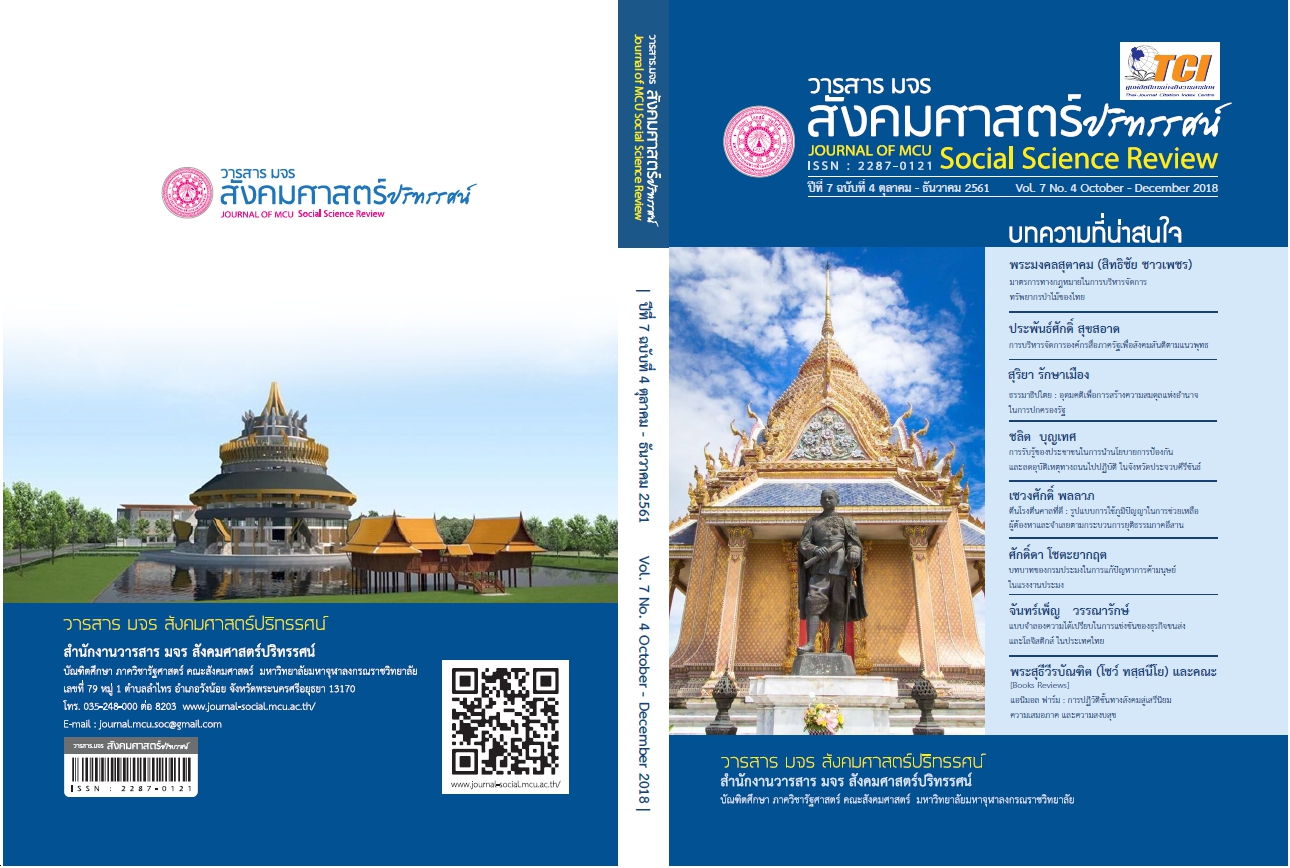วิเคราะห์คุณค่าเชิงมโนทัศน์ทางพุทธสุนทรียศาสตร์กับการหยั่งรู้ธรรม
คำสำคัญ:
มโนทัศน์, สุนทรียศาสตร์, พระพุทธศาสนา, คุณค่าบทคัดย่อ
บทความนี้เป็นส่วนหนึ่งของการศึกษาวิจัยเรื่อง “วิเคราะห์เชิงคุณค่ามโนทัศน์ทาง
พุทธสุนทรียศาสตร์กับการหยั่งรู้ธรรม” มีวัตถุประสงค์ 3 ประการ คือ 1) เพื่อศึกษาคุณค่าเชิง
มโนทัศน์ทางสุนทรียศาสตร์ 2) เพื่อศึกษามโนทัศน์สุนทรียศาสตร์ของพระพุทธศาสนา3) เพื่อ
วิเคราะห์คุณค่าเชิงมโนทัศน์พุทธสุนทรียศาสตร์ต่อการหยั่งรู้ธรรมในพระพุทธศาสนา งานวิจัย
ชิ้นนี้เป็นการศึกษาเชิงคุณภาพ
จากผลการศึกษา พบว่า มโนทัศน์ทางสุนทรียศาสตร์โดยทั่วไปศึกษาเน้นการศึกษา
เรื่องความงามและความไม่งามในงานศิลปะและธรรมชาติ รวมถึงคุณค่าทางความรู้สึกที่เกิด
ขึ้นกับอารมณ์ของมนุษย์ ส่วนมโนทัศน์ทางพุทธสุนทรียศาสตร์ มุ่งเน้นการศึกษาในเรื่องความ
งามใน 2 มิติ คือ ความงามในมิติทางธรรมและความงามมิติทางโลก ประเภทของสุนทรียศาสตร์
ในพระพุทธศาสนา ที่พบในคัมภีร์พระไตรปิฎก กล่าวถึงทัศนคติที่มีต่อความงามและความไม่
งามในพระพุทธศาสนา สามารถแบ่งออกเป็น 2 ประการ คือ 1) สุนทรียศาสตร์เชิงวัตถุวิสัย คือ
ประสบการณ์การรับรู้ทางสุนทรียะที่เกี่ยวข้องกับรูปธรรม เช่น ในธรรมชาติ ในกายมนุษย์ ใน
วัฒนธรรม และในศิลปะและ 2) สุนทรียศาสตร์เชิงจิตวิสัย คือ ประสบการณ์การรับรู้ทาง
สุนทรียะที่เกี่ยวข้องกับนามธรรม เช่น รูปสัมผัส สัททสัมผัส คันธสัมผัส รสสัมผัส กายสัมผัส
และอารมณ์สัมผัส ในส่วนของเกณฑ์การตัดสินคุณค่าของพุทธสุนทรียศาสตร์ สามารถแยก
ออกเป็น 3 แบบ (1) เชิงสมภาวะ (2) เชิงเอกภาวะ และ (3) เชิงสัจภาวะ ในส่วนคุณค่าทาง
สุนทรียศาสตร์ในพระพุทธศาสนานั้น สามารถแยกออกเป็น 3 แบบ คือ (1) เชิงศีลธรรม (2)
เชิงศิลปะ และ (3) เชิงพุทธศิลป์
เอกสารอ้างอิง
Edwards (ed.). New York: The Macmillan Company & The Free Press.
Kamchorn Soonpongsri. (2013). Aesthetics. Bangkok : Mahachulalongkornjajavidayalaya
Printing House.
Kalupahana, David J. (1992). A History of Buddhist Philosophy: Continuities
and Discontinuities. Honolulu: University of Hawaii Press.
Mahachulalongkornjajavidayalaya. (1996). Thai Tipitaka MCU Version. Bangkok :
MCU Printing House.
Nigel Wilson. (2010.) Encyclopedia of Ancient Greece. New York : Rutledge.
Phra Brahma Gunabhorn (P.A. Payutto). (2008). Dictionary of Buddhism. 16
Editions. Bangkok : SR Printing Mass Production Co. Ltd.
Phra Brahma Gunabhorn (P.A. Payutto). (2012). Buddhadhamma. Extended
Edition. 32nd Edition. Bangkok : P.A. Payutto Foundation.
Royal Institute. (1987). Dictionary of Art: Thai English. Bangkok : Royal Institute.
Somdet Phra Sangharaja Chao Kromma Luang Jinavorn Sirivaddhana. (1965).
Abhidhanappadipika Scripture. Bangkok : Mahamakut Printing House.
ดาวน์โหลด
เผยแพร่แล้ว
รูปแบบการอ้างอิง
ฉบับ
ประเภทบทความ
สัญญาอนุญาต
ลิขสิทธิ์ (c) 2019 วารสาร มจร สังคมศาสตร์ปริทรรศน์

อนุญาตภายใต้เงื่อนไข Creative Commons Attribution-NonCommercial-NoDerivatives 4.0 International License.
เพื่อให้เป็นไปตามกฎหมายลิขสิทธิ์ ผู้นิพนธ์ทุกท่านต้องลงลายมือชื่อในแบบฟอร์มใบมอบลิขสิทธิ์บทความให้แก่วารสารฯ พร้อมกับบทความต้นฉบับที่ได้แก้ไขครั้งสุดท้าย นอกจากนี้ ผู้นิพนธ์ทุกท่านต้องยืนยันว่าบทความต้นฉบับที่ส่งมาตีพิมพ์นั้น ได้ส่งมาตีพิมพ์เฉพาะในวารสาร มจร สังคมศาสตร์ปริทรรศน์ เพียงแห่งเดียวเท่านั้น หากมีการใช้ภาพหรือตารางหรือเนื้อหาอื่นๆ ของผู้นิพนธ์อื่นที่ปรากฏในสิ่งตีพิมพ์อื่นมาแล้ว ผู้นิพนธ์ต้องขออนุญาตเจ้าของลิขสิทธิ์ก่อน พร้อมทั้งแสดงหนังสือที่ได้รับการยินยอมต่อบรรณาธิการ ก่อนที่บทความจะได้รับการตีพิมพ์ หากไม่เป็นไปตามข้อกำหนดเบื้องต้น ทางวารสารจะถอดบทความของท่านออกโดยไม่มีข้อยกเว้นใดๆ ทั้งสิ้น





